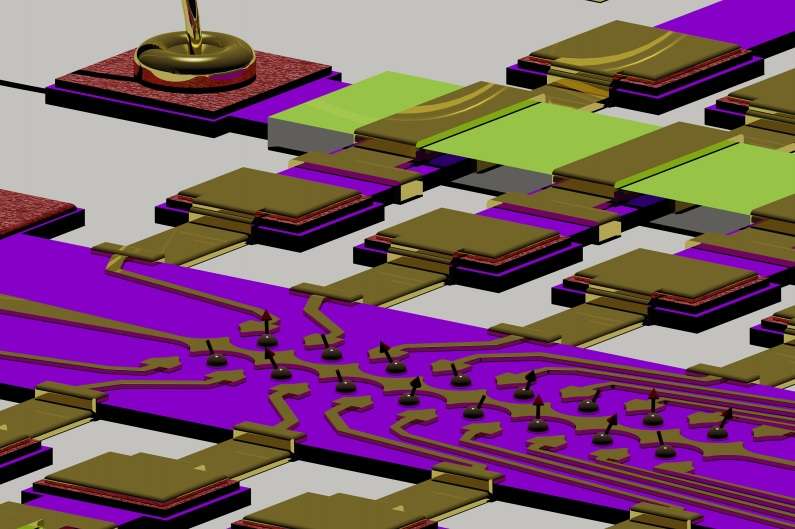3D artist impression of a large array of quantum devices in which charge is “locked” onto the electrodes, which allows each wire to act like multiple wires. Credit: R. K. Puddy, University of Cambridge
(Phys.org)—When it comes to fabricating complex quantum devices, one limitation is the number of wires available on the measurement systems that the quantum devices are built on. Typically, controlling just three or four quantum dots requires about 20 wires, which is the limit of many systems. In a new study, engineers have devised a method that in principle can control 14 quantum dots using 19 wires. This improvement provides a way to build larger arrays of quantum devices, which could be useful for scaling up quantum computers and quantum information processing systems.
The researchers, Reuben K. Puddy, et al., at the University of Cambridge, have published a paper on the new method for scaling up quantum devices in a recent issue of Applied Physics Letters.
"Our design may facilitate quantum computation and other future tech," Puddy told Phys.org. "The design allows for the measurement of devices of greater complexity than otherwise achievable."
The technique builds on previous work that has used a multiplexer (which forwards one of several input signals into a single output signal) to increase the number of quantum devices. Here, the researchers used a multiplexer to "lock" charge onto the device's electrodes, which enables a single wire to act like multiple wires.
"A quantum device requires gate electrodes, sitting at fixed voltages, in order to operate," Puddy explained. "Usually each electrode is controlled directly by a voltage source connected by a wire to the gate electrode. The multiplexer and our charge locking system allows us to use a single voltage source and wire to charge up multiple gate electrodes individually to the desired voltage and lock that voltage onto the gate before moving on to the next gate electrode. Each of your available wires therefore becomes multiple wires and so larger, more complex geometries can be fabricated."
The new method works for any system, whether it has 20 wires or 2000, by exponentially increasing the number of usable gate electrodes per wire.
"For example, 10 wires would give you 32 gates, 20 wires gives you 1024 gates," Puddy said.
Another benefit of reducing the number of wires needed to build a given number of gates is heat reduction. Heat reduction is vital for quantum computers, which require low temperatures to operate, and yet currently require a large number of wires due to the need for multiple error correction devices.
More information: R. K. Puddy, et al. "Multiplexed charge-locking device for large arrays of quantum devices." Applied Physics Letters. DOI: 10.1063/1.4932012
Journal information: Applied Physics Letters
© 2015 Phys.org
























